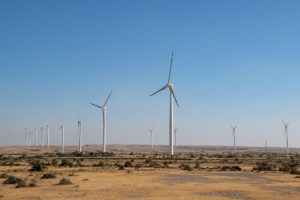In late August, a new coal power plant, Nghi Son 2, was inaugurated in Vietnam. At the ceremony, the project’s director claimed the 1.2-gigawatt (GW) plant would run “a green operation” and help the country realise its commitment to reach net-zero carbon emissions by 2050. He did not explain how a coal plant, albeit one utilising more efficient supercritical technology, was aligned with reducing Vietnam’s emissions.
Vietnam is at a crossroads. At the UN climate talks in Glasgow last year, Prime Minister Pham Minh Chinh announced the 2050 net-zero target, but the country is expected to make an additional 2.4 GW of coal capacity operational by the end of this year and has about 14 GW in the pipeline to 2030. If the latest draft of Vietnam’s eighth power development plan (PDP8) is approved, it will put the country in the top five for largest coal fleet in development.
In the latest draft plan, the current coal-heavy energy pathway is called the “balanced” option. An earlier version of the PDP8, published in March, included a second pathway called “a strong transition to renewable energy”. The second pathway in the March draft would have capped coal power at around 30 GW, up from about 25 GW now, and resulted in no more coal projects after 2026. However, the most recent drafts of the plan have dropped the transition pathway altogether.
That transition pathway would have aligned Vietnam with its net zero commitment, but an internal report from the prime minister’s office released shortly after the March draft shows that the Ministry of Industry and Trade (MoIT) is discouraging renewables, in part because of legal ramifications if incipient coal projects were cancelled and because it would require the abandonment of “9,450 MW of nine coal-fired power projects that have been deployed and prepared for investment, or have BOT [build–operate–transfer] contracts/agreements signed but face funding difficulty.”
The PDP8 has been delayed and revised five times in just two years. The MoIT has been instructed by the prime minister’s office to revise the solar capacity targets and clarify potential legal issues with regard to terminating coal power projects. The office’s internal report does not specify which projects may face legal issues.
Coal projects that don’t add up
Flora Champenois, a project manager at the NGO Global Energy Monitor, has attempted to work out the coal capacity numbers and decipher the MoIT’s thinking. “We’re not able to make any combination of nine [plants] that add up to 9,450 MW. There are nine that add up to 9,460 MW, which is obviously close but not a match,” she says.
Of the projects identified by Champenois, only one has a public record of a legal case: Long Phu 1. In 2013, Power Machines, a Russian contractor, signed a contract to build the plant with Vietnam’s oil and gas conglomerate PetroVietnam (PVN). In 2018, a third of the way to completion, Power Machines could not continue because the US put them on an embargoed list of Russian companies, making it impossible for them to procure equipment.
PVN did not accept the US’s sanction as force majeure, and in 2019 Power Machines took PVN to the Singapore International Arbitration Centre. The Russian contractor wanted to withdraw from the contract with no losses and receive compensation.
It is unclear how the lawsuit has played out. Tien Phong News reported earlier this year that Long Phu’s management board is pleading with PVN to terminate the contract with Power Machines. In the PDP8 draft, a negotiation with the contractor is still ongoing and Long Phu 1 is listed for completion in 2027.
“I flinch a little from this argument of lawsuits because MoIT and the prime minister are well within their rights to say this is our grid, this is our country. So we get to decide what will be put on it,” says Isabella Suarez, an analyst at think tank the Centre for Research on Energy and Clean Air.
Suarez called the possibility of lawsuits a “diversionary tactic”, pointing out that this is an opportunity for signed contracts to be renegotiated and converted. Instead of scrambling to find funding for a technology that most countries are now spurning, Vietnam could find more resources and prioritise renewable energy.
The China factor
Vietnam’s net zero commitment followed China’s announcement a few months earlier that it would stop building new coal projects abroad. China is the biggest financier of coal power in Vietnam and also the last international one. It is financing the construction of two projects: Thai Binh 2 and Van Phong 1. According to the draft PDP8, Thai Binh 2 is expected to come online by the end of the year, while Van Phong 1 is scheduled for 2023.
Referring to a pledge made by Chinese President Xi Jinping in September 2021, Cecilia Springer, a senior researcher with the Global China Initiative at Boston University, said:
“Everybody is waiting to see how that short phrase ‘not building new coal-fired power projects abroad’ would be institutionalised into policy.” The first major indication of a clear policy framework came in March this year, according to Springer. It took the form of “Opinions on Jointly Promoting Green Development of the Belt and Road, a document jointly issued by the National Development and Reform Commission and three government ministries. Beyond confirming the prohibition of new plants, the Opinions say “…prudently proceed with existing ones that are under construction”.
Who will fund coal?
From 2025 and beyond, the draft PDP8 plans a further 10 coal projects although half have not secured funding. Springer says they are unlikely to proceed.
“Who will finance these plants if China walks away? Our research shows it may be domestic financiers or the private sector. It would certainly not come from public finance… many places have introduced restrictions,” she said, referring to the unwillingness of states and private investors to back new overseas coal.
President Xi’s pledge wasn’t just a ban on overseas coal, it was also an increase in investment in renewable energy. But there has to be demand from the host country.Isabella Suarez, the Centre for Research on Energy and Clean Air
Most of the plants that would have attracted Chinese finance are noted as “hard to secure capital” in the latest PDP8 draft. These plants add up to 7 GW. The MoIT is telling project owners that if the coal plants are going ahead, they must present commitments by financiers in writing by the end of October. However, the MoIT also said that to avoid legal issues, the projects will still be listed in the PDP8 until any termination procedures are completed.
“I think the Vietnamese government should be very cautious about how much coal they have in the pipeline. And if they can start cancelling projects already, it will free up so much anxiety and burden,” Suarez said.
“President Xi’s pledge wasn’t just a ban on overseas coal, it was also an increase in investment in renewable energy. But there has to be demand from the host country,” she added.
“Host countries are immensely powerful; sovereignty is a big part of the equation.”








